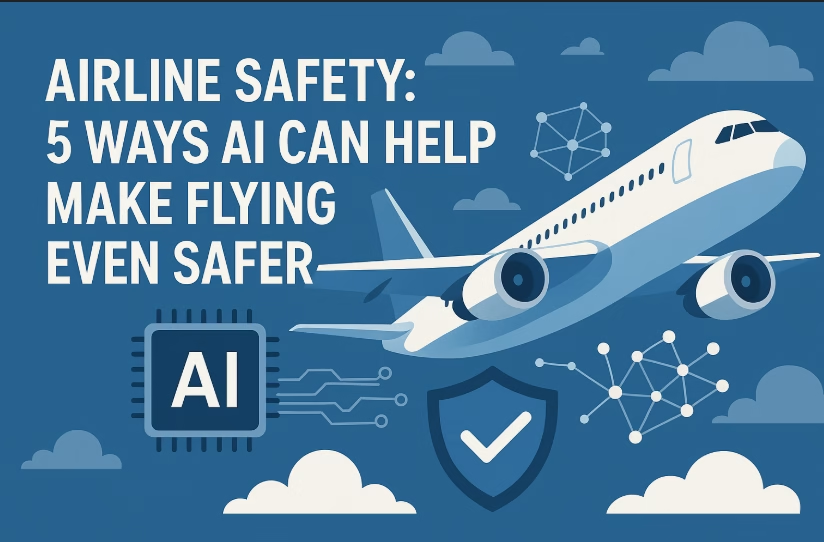Flying is already one of the safest forms of travel, but as air traffic continues to increase, so does the demand for even higher safety standards. Artificial Intelligence (AI) is rapidly becoming the co-pilot of the future—quietly transforming aviation operations behind the scenes. From monitoring aircraft health to detecting threats in real-time, AI offers powerful tools to help airlines safeguard passengers and crew like never before. In this blog, we’ll explore five impactful ways AI is making air travel even safer—for tech enthusiasts, parents, and anyone who’s ever looked out of an airplane window and wondered how it all works so flawlessly.
1 Predictive Maintenance: Fixing Problems Before They Happen
Traditional aircraft maintenance follows scheduled checks, but AI has introduced – predictive maintenance- , a game-changer that allows airlines to detect mechanical issues – before they become failures- .
- AI analyzes real-time data from sensors embedded throughout the aircraft.
- It predicts when a component is likely to fail and alerts ground teams in advance.
- Airlines like Delta and Lufthansa have already implemented AI-driven maintenance systems, reducing unscheduled maintenance events by up to – 30%- .
This proactive approach ensures aircraft remain in optimal condition, reducing delays and increasing safety margins.
2 Pilot Assistance and Decision Support
AI doesn’t replace pilots—it – empowers them- .
- Advanced AI co-pilot systems assist in managing complex scenarios like extreme weather or emergency landings.
- AI can process massive datasets instantly, offering – real-time decision support- based on flight path, fuel levels, and traffic conditions.
- Airbus’ “Skywise” platform is a leading example, helping pilots make data-informed decisions faster and more accurately.
By reducing cognitive load and human error, AI allows pilots to focus on critical judgment and strategy.
3 Enhanced Air Traffic Control (ATC) Operations
Air traffic is projected to – double by 2040- , and traditional ATC systems are already under pressure.
- AI enhances ATC by optimizing flight paths, reducing congestion, and improving communication.
- Tools like NASA’s – Airspace Technology Demonstration- have shown AI can reduce gate-to-gate time by – 15%- while improving safety.
- AI systems help controllers manage unpredictable events like weather or rerouted aircraft more efficiently.
The result? A safer and smoother experience for both passengers and flight crews.
4 Real-Time Threat Detection and Security
AI excels at analyzing vast streams of data for anomalies—making it perfect for – threat detection and prevention- .
- AI-powered facial recognition and behavior analysis systems in airports can detect suspicious activity in real time.
- Machine learning algorithms can monitor communications and network traffic to identify cybersecurity threats before they impact aircraft systems.
- Boeing and Airbus are investing heavily in AI-based – cybersecurity frameworks- to guard against potential sabotage.
With AI, security doesn’t just react—it predicts and prevents.
5 AI in Weather Forecasting and Turbulence Prediction
Unpredictable weather is a major safety and comfort concern in aviation.
- AI models use satellite data, radar inputs, and historical trends to – forecast storms, turbulence, and wind patterns- with unprecedented accuracy.
- Companies like IBM’s – The Weather Company- are working with airlines to integrate AI-enhanced forecasts into flight planning systems.
- These insights allow pilots to reroute flights – before- turbulence hits, improving safety and passenger comfort.
Safer skies begin with smarter weather predictions—and AI is the radar of the future.
The Future of Safer Skies Is Powered by AI
Air travel is already incredibly safe, but AI is ushering in a new era of – intelligent safety systems- that learn, adapt, and respond faster than ever before. Whether it’s helping pilots in the cockpit, predicting mechanical issues, or improving airport security, AI stands as an invisible guardian of the skies. As these technologies continue to evolve, passengers can expect a future where flying is not just efficient—but – safer and smarter- than ever imagined.
Saksham Kaushik is a talented writer and knowledge seeker who enjoys studying and sharing knowledge on everyday happenings, trends, and interesting facts. With keen observation skills and a curiosity-based approach, He analyzes heavy subjects into simple-to-read articles, keeping readers updated and interested. From international updates to technology breakthroughs, lifestyle suggestions, and food for thought, Saksham Kaushik provides new insights and useful information every day.




